
What is the tooling cost for die casting?
2025-04-15 14:22
In the manufacturing landscape, die casting has emerged as a popular and efficient method for producing high - volume, precision - engineered parts. However, one of the most critical factors that manufacturers and businesses need to consider when opting for die casting is the tooling cost. This cost can significantly impact the overall economics of a production project, and understanding its components and influencing factors is essential for making informed decisions.
Components of Die Casting Tooling Cost
The tooling cost for die casting primarily revolves around the creation of the die itself. A die is a specialized mold into which molten metal, such as aluminum, zinc, or magnesium alloys, is injected under high pressure to form the desired shape. The die consists of two main parts: the cavity, which forms the external shape of the part, and the core, which creates any internal features like holes or cavities. The cost of fabricating these components is a major part of the tooling expense.
Materials used in die - making play a substantial role. High - quality toolsteels are commonly employed due to their ability to withstand the high - pressure and high - temperature conditions of die casting. These steels are often alloyed with elements like chromium, molybdenum, and vanadium to enhance their hardness, wear resistance, and toughness. The cost of these specialized steels can vary significantly depending on their composition and quality. For example, a die made from premium - grade tool steel with advanced alloying elements will be more expensive than one made from a standard grade.
Manufacturing processes involved in creating the die also contribute to the cost. Precision machining operations, such as milling, turning, and electrical discharge machining (EDM), are required to achieve the intricate details and tight tolerances necessary for die casting. EDM, in particular, is often used to create complex shapes and fine features that are difficult to machine conventionally. The time and expertise required for these machining processes, along with the cost of the machinery and its maintenance, add to the overall tooling cost.
Influencing Factors on Tooling Cost
The complexity of the part design is a key determinant of die casting tooling cost. Parts with intricate geometries, thin walls, undercuts, and multiple features require more elaborate die designs. More complex dies need additional components, such as slides, lifters, and cores, to facilitate the removal of the cast part from the mold. Designing and manufacturing these additional elements significantly increases the cost. For instance, a die for casting a simple, solid - shaped component will be far less expensive than one for a highly detailed automotive component with internal cooling channels and complex outer contours.
The size of the part also impacts the tooling cost. Larger parts require larger dies, which means more material for construction. Additionally, the machining operations for larger dies are more time - consuming and may require larger, more powerful machinery. A large - scale industrial component, like a heavy - duty engine block, will necessitate a massive die, resulting in a much higher tooling cost compared to a small, handheld consumer product.
Production volume is another crucial factor. While the initial tooling cost is a fixed expense, spreading this cost over a large number of parts can make it more affordable on a per - unit basis. For high - volume production runs, the investment in tooling becomes more justifiable. In contrast, for low - volume production, the per - unit cost of tooling can be prohibitively high. For example, if a company plans to produce only a few hundred units of a product, the tooling cost may account for a significant portion of the total cost per unit. However, if the production volume is in the hundreds of thousands or more, the tooling cost per unit becomes a relatively small fraction of the overall cost.
Cost - Saving Strategies
To mitigate the high tooling cost for die casting, manufacturers can adopt several strategies. One approach is to optimize the part design early in the product development process. By working closely with die - casting engineers, designers can simplify the part geometry without sacrificing its functionality. This can reduce the complexity of the die and, consequently, the tooling cost. For example, eliminating unnecessary undercuts or using more standard shapes can make the die - making process more straightforward.
Another strategy is to choose the right die - casting partner. A well - established and experienced die - casting company may have more efficient manufacturing processes, better - equipped facilities, and a larger pool of skilled workers. This can lead to cost savings in die production. Additionally, some die - casting companies may offer cost - sharing arrangements for high - cost tooling in exchange for long - term production contracts.
In conclusion, the tooling cost for die casting is a multifaceted aspect of the manufacturing process. It is influenced by various factors, including the components of the die, part complexity, size, and production volume. By understanding these elements and implementing cost - saving strategies, manufacturers can make more cost - effective decisions when considering die casting for their production needs. As the die - casting industry continues to evolve, advancements in materials, manufacturing technologies, and cost - management strategies may further impact and potentially reduce the tooling cost, making die casting an even more attractive option for a wider range of applications
Get the latest price? We'll respond as soon as possible(within 12 hours)












